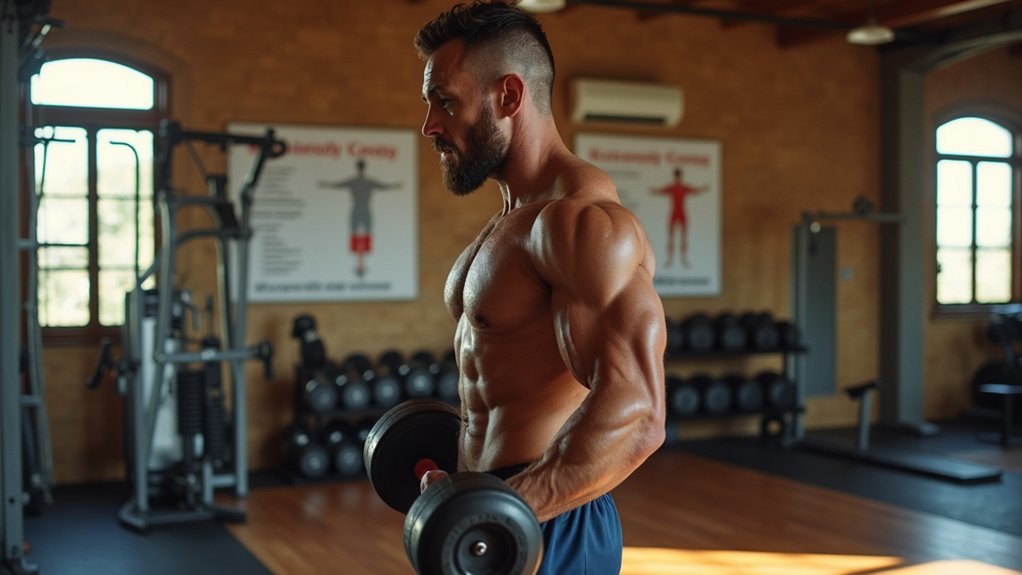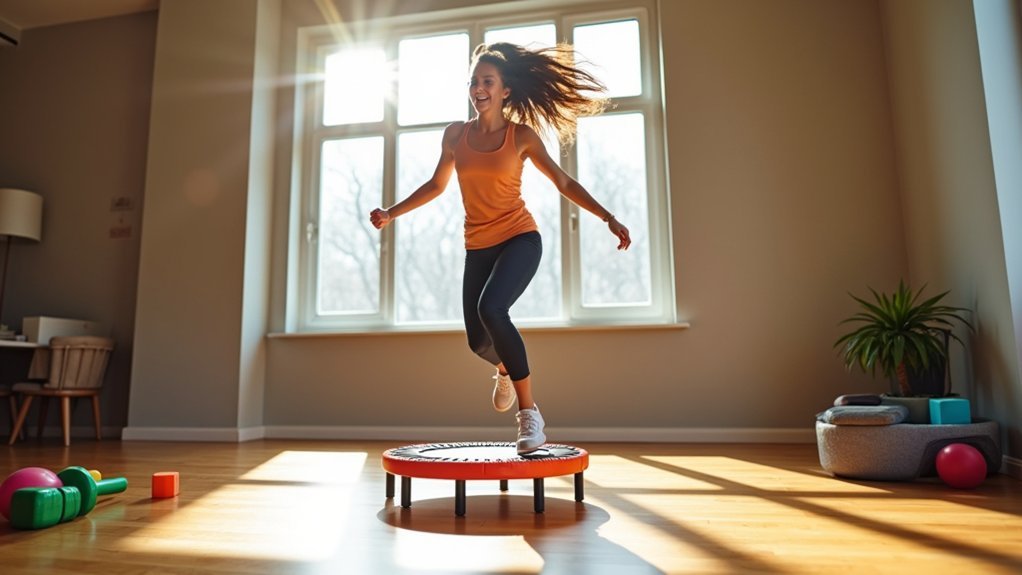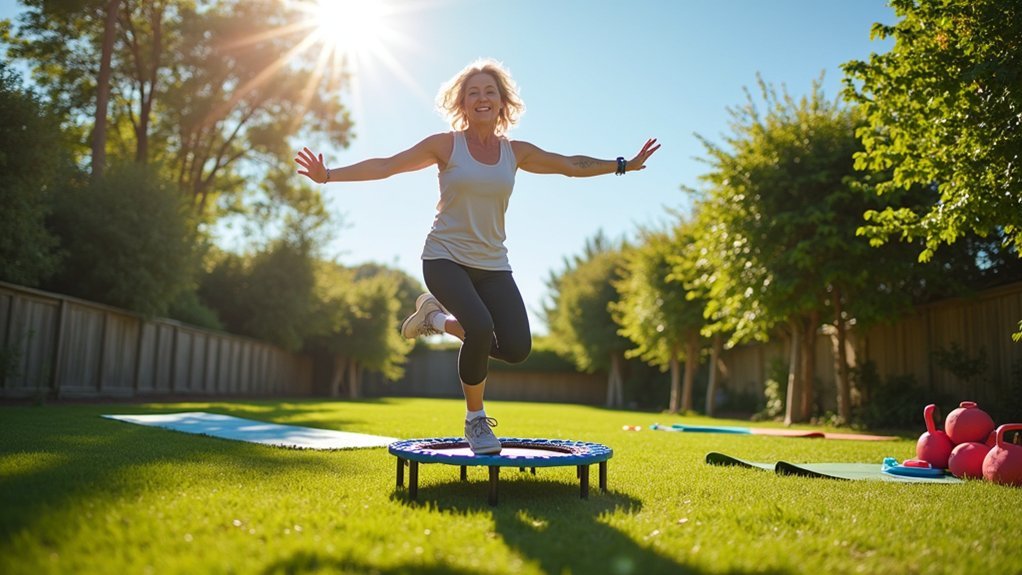Rebounding on a mini-trampoline offers an effective way to boost your bone density with low-impact exercise. The repeated impact forces stimulate bone remodeling, particularly in your spine and hips, while improving balance and coordination. Just 20-30 minutes several times weekly can yield significant improvements in bone health. Start with short bounces, gradually increase intensity, and combine with resistance training for best results. Discover how this simple exercise can transform your skeletal strength for decades to come.
Why Men Need to Focus on Bone Density

Although bone health is often considered a women’s issue, men face their own significant risks for osteoporosis as they age. In fact, 1 in 4 men over 50 will experience a fracture related to weakened bones.
Unlike women, you’ll reach peak bone density around age 30, making ongoing maintenance vital. When testosterone levels drop with age, you can lose up to 30% of your bone mass in just a few years. This dramatic decline increases your fracture risk substantially.
Men experience bone density plateau at 30, with significant loss possible as testosterone declines—making bone maintenance critical for long-term health.
Your naturally higher muscle mass helps strengthen bones, but only if you stay active. Weight-bearing exercise and resistance training twice weekly are essential for maintaining bone density.
Without regular physical activity, you’ll lose the protective benefits your muscular frame provides, accelerating bone loss and increasing osteoporosis risk.
Understanding the Science of Rebounding and Bone Health
When exploring effective bone-strengthening exercises beyond traditional weightlifting, rebounding stands out as a powerful yet often overlooked option. This weight-bearing exercise creates impact forces that stimulate bone remodeling while remaining gentle on your joints.
- Each bounce on a mini-trampoline sends waves of compression through your skeletal system, triggering cells to build stronger bones.
- The dynamic, multidirectional movements enhance balance and coordination, essential for preventing falls—especially if you’re at risk for osteoporosis.
- You’ll experience significant improvements in bone density, particularly in vulnerable areas like hips and spine, with just 20-30 minutes of regular rebounding.
- The low-impact nature makes it accessible regardless of fitness level, allowing you to strengthen bones without straining joints.
This combination of benefits makes rebounding an ideal addition to your bone health routine.
The Benefits of Rebounding vs. Traditional Exercise

While traditional exercises like running and weight training effectively build bone density, rebounding offers unique advantages that set it apart. This low-impact activity reduces joint stress while still qualifying as a weight-bearing exercise that helps strengthen bones.
You’ll experience improved bone mineral density, particularly in your spine and lower body, without the harsh impact of running. Rebounding engages multiple muscle groups simultaneously, enhancing your balance and coordination—crucial skills for preventing falls and fractures.
Perhaps most appealingly, you don’t need much space or equipment—just a mini-trampoline for convenient home workouts.
Beyond bone health benefits, you’ll boost your cardiovascular health and lymphatic circulation with each bounce. For those seeking an all-encompassing workout that’s gentle on joints but effective for building bone, rebounding delivers impressive results.
Getting Started: Essential Rebounding Equipment
You’ll need a quality mini-trampoline with a sturdy frame and non-slip surface to begin your bone-strengthening rebounding routine.
For safety, look for models with padded edges and sufficient weight capacity to support your exercises.
While basic rebounders work well for beginners, premium options with adjustable tension and enhanced stability features offer greater versatility as you progress in your bone density workouts.
Basic Rebounding Equipment
Getting started with rebounding requires minimal yet specific equipment. The centerpiece is a quality mini-trampoline that supports bone strength through low-impact exercise. When selecting your rebounder, prioritize one that matches your weight capacity to guarantee safety and longevity.
- Choose a model with a sturdy frame and non-slip surface to prevent accidents during your workout.
- Look for adjustable resistance bands to customize intensity as your strength improves.
- Consider a foldable design if space is limited in your home.
- Enhance your routine with accessories like hand weights for added challenge.
Premium Options Available
For those seeking advanced rebounding benefits, premium models offer enhanced features that maximize both safety and bone-strengthening potential.
High-end rebounders feature aerospace-grade bungee systems that provide smoother, deeper bounces while protecting your joints during weight-bearing activity.
Look for models with adjustable tension settings, allowing you to customize resistance as your bone density improves.
Many premium options include fold-up designs for convenient storage and digital monitors to track your progress.
Consider packages that include resistance bands to strengthen muscles throughout your exercise program.
Premium rebounders typically support higher weight capacities (up to 400 pounds) and offer extended warranties.
The investment pays off through enhanced durability and superior bounce quality.
While basic models deliver excellent benefits, these upgraded options provide ideal conditions for long-term bone health development.
Key Rebounding Techniques for Maximum Bone Impact

While many exercise methods support bone health, rebounding stands out as a particularly effective option for building density. This low-impact, weight-bearing exercise stimulates your bones through vertical impact, strengthening them with each bounce.
For best results, incorporate these techniques into your routine 2-3 times weekly:
- Perform short, intense bursts of 30-second bounces followed by brief rest periods to maximize bone stimulation
- Vary your movements and directions to engage multiple muscle groups and enhance overall bone health
- Target your lower body and spine specifically, where bone density improvements are most significant
- Gradually increase your intensity by jumping higher or adding arm movements for progressive bone-strengthening benefits
You’ll notice improved balance and coordination as added benefits while building stronger bones.
Progressive Intensity: Building a Sustainable Routine
Building a bone-strengthening exercise routine isn’t about jumping into high-intensity workouts immediately—you’ll want to start with manageable weights and impact levels that challenge without overwhelming.
As your strength improves and your body adapts, gradually increase resistance in strength training and impact in weight-bearing activities while tracking improvements in your endurance and form.
Remember to honor your body’s signals, adjusting intensity when needed and celebrating progress, whether it’s lifting heavier weights or extending your walking distance.
Start Small, Grow Gradually
The path to stronger bones begins with a gentle approach that prevents injury while building confidence. Start with low-impact activities like walking or yoga to assess your comfort level before advancing to more challenging exercises to strengthen your bones.
- Begin with 20-30 minutes of muscle-strengthening exercises 2-3 days weekly.
- Gradually build intensity by adding resistance bands or weights as your strength improves.
- Aim for 3 sets of 8-12 repetitions for each major muscle group.
- Incorporate balance and flexibility exercises to enhance stability and prevent falls.
Listen to your body as you progress. If you experience pain during your workout, adjust your routine and consult a healthcare professional.
Track Your Progress
Three key elements help you effectively track your bone-strengthening journey: consistent monitoring, gradual progression, and professional guidance.
Dedicate at least 150 minutes weekly to moderate aerobic activity, plus strength training twice weekly to build bone density.
Keep a detailed exercise log recording your activities, duration, and intensity levels. This documentation helps identify patterns and celebrate milestones as your bone health improves.
As you gain strength, carefully increase workout intensity with more challenging weight-bearing exercises while maintaining proper form.
Listen to your body’s signals during this progression—any unusual discomfort might indicate you need to adjust your routine.
Regular consultations with healthcare providers or certified trainers guarantee you’re on the right track. Their expertise helps fine-tune your exercise plan as your strength develops and bone density increases.
Listen To Your Body
While tracking progress provides the data for your bone-building journey, learning to interpret your body’s signals will keep you safe and successful long-term.
Exercise for your bones shouldn’t cause pain—discomfort during workouts requires immediate attention.
- If you experience back pain or joint strain, adjust your technique or reduce resistance rather than pushing through.
- Start with low-impact activities and gradually increase intensity as your fitness improves.
- Consult a physical therapist if you’re unsure about proper form or experience persistent discomfort.
- Regularly assess your progress and modify your routine to prevent falls and injuries.
Your body communicates valuable information during exercise. By listening attentively, you’ll create a sustainable routine that builds bone density without unnecessary risks.
Measuring Your Bone Density Progress
How can you know if your bone-strengthening efforts are actually working? The most reliable way to track improvement is through DEXA scans, which provide precise measurements of your bone mineral content and can detect conditions like osteoporosis early.
For those committed to exercises that strengthen your bones, patience is key—significant increase in bone density typically takes months to years of consistent effort.
Schedule regular DEXA scans as recommended by your healthcare provider, especially if you’re at higher risk for bone loss.
Between scans, keep detailed records of your exercise routines, nutrition, and any physical changes you notice.
While you can’t see your bones getting stronger, improving scan results and decreased fracture risk are meaningful indicators that your bone density is improving and your hard work is paying off.
Combining Rebounding With Other Bone-Strengthening Activities
For ideal bone health, rebounding on a mini-trampoline shouldn’t stand alone in your exercise routine.
While rebounding effectively builds bone density through impact forces, combining it with other activities creates a thorough approach to strengthen your skeletal system and prevent osteoporosis.
- Add resistance training with light weights or bands during your rebounding sessions to increase muscle strength, which applies greater force to your bones.
- Incorporate balance exercises like one-leg stands or tai chi to improve stability and reduce fall risks.
- Vary your rebounding movements with side-to-side jumps and turns to target different bone sites.
- Complement your rebounding routine with other weight-bearing exercises such as brisk walking or dancing.
This multi-faceted approach guarantees you’re maximizing bone-strengthening benefits while making your workout more engaging and effective.
Overcoming Common Rebounding Challenges for Men
Three common challenges often prevent men from reaping the full bone-strengthening benefits of rebounding exercises.
First, joint concerns—particularly for those with arthritis—can make high-impact exercise seem intimidating. Start with low-impact variations that still increase bone density while protecting joints.
Second, many men struggle balancing strength workouts with rebounding activities. The solution? Integrate both: resistance training twice weekly targets major muscle groups, which in turn protects bones during rebounding sessions.
Third, consistency issues derail progress. Remember, preventing osteoporosis requires at least 150 minutes of moderate activity weekly. Create a realistic schedule combining rebounding with walking or jogging for best results.
Though men typically start with higher bone density than women, maintaining it requires dedicated effort as you age—making these challenges worth overcoming.
Frequently Asked Questions
What Exercise Increases Bone Density the Most?
High-impact activities, like jumping and racket sports, increase bone density the most. You’ll build stronger bones when you combine these with weight-bearing exercises and resistance training at least twice weekly.
How Long Does It Take to Increase Bone Density With Exercise?
You’ll need about 6-12 months of consistent weight-bearing and resistance exercises to see significant improvements in bone density. You’ll typically gain 1-3% per year, with better results from high-intensity training.
Can You Reverse Osteoporosis With Exercise?
You can’t completely reverse osteoporosis with exercise alone, but you’ll considerably improve bone density and reduce fracture risk through regular weight-bearing and resistance activities. It’s an essential part of managing the condition effectively.
What Activities Is Best for Increasing Bone Density?
For increasing bone density, you’ll benefit most from weight-bearing exercises like walking and running, resistance training, and high-impact activities such as jumping. Don’t forget to include balance exercises like yoga to prevent falls too.
In Summary
You’ve got the tools to strengthen your bones through rebounding. Start small, progress consistently, and track your results. This low-impact exercise delivers high-impact benefits for your bone density in ways traditional workouts can’t match. By incorporating rebounding into your routine, you’ll protect your skeletal health while enjoying a workout that’s easy on your joints. Your future self will thank you.




Leave a Reply